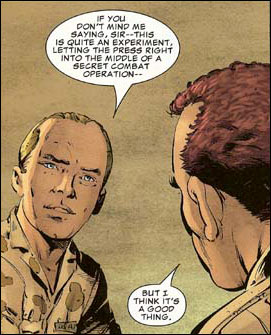July 2006
Eye for an Eye
Two poster mockups. Click above for high resolution PDF’s. Please reproduce and distribute.
Got a another idea? Here’s the unicode text.
Notes in Time Out

This week’s Time Out New York is running six pictures of Japanese manhole covers I took in 2002. It’s part of the cover story on “how to make New York better by stealing the best ideas from other cities.”
The photo editor found this old blog post and contacted me.
(And seeing it in print, I think the first photo is upside down. I always thought it was birds against the sky, but now I think it might be flowers against a river...)
 This year’s National Design Award winners in graphic design refuse to attend the awards breakfast with Laura Bush at the White House. See their joint letter in protest at Design Observer, as well as Chip Kidd’s reasons why he chose to go anyway. Regarding the Administration, I can think of a few more specific crimes than “crimes against discourse” and an “assault on meaning,” but it’s nice to see some graphic design heavyweights taking political action.
This year’s National Design Award winners in graphic design refuse to attend the awards breakfast with Laura Bush at the White House. See their joint letter in protest at Design Observer, as well as Chip Kidd’s reasons why he chose to go anyway. Regarding the Administration, I can think of a few more specific crimes than “crimes against discourse” and an “assault on meaning,” but it’s nice to see some graphic design heavyweights taking political action.Domestic Policy
Another item I missed while out, on May 24, President Bush appointed Karl Zinsmeister as his chief domestic policy advisor (replacing Claude Allen who resigned in February when caught stealing from Target.) Judging from the appointment, the domestic agenda seems more about propaganda than poverty.
His qualifications? Zinsmeister was editor of The American Enterprise, the magazine of the American Enterprise Institute, a neo-conservative think tank whose stated mission is to support the “foundations of freedom — limited government, private enterprise, vital cultural and political institutions, and a strong foreign policy and national defense.” Among the organization’s funders are both Microsoft and the Scaife family.
Also on his resume, in 2003, Zinsmeister was embedded as a military reporter with the 82nd Airborne in Iraq. His Iraq experience is chronicled in Combat Zone: True Tales of GI’s in Iraq, which Zinsmeister wrote for Marvel Comics. [source] The comic excludes accounts of torture and detainee abuse by the 82nd Airborne later documented by Human Rights Watch.
Further qualifying him, is Zinsmeister’s 2002 essay When Art Becomes Inhuman, a critique of modern art, liberals, and, of course, Manhattan. [source]. His rant against abstraction is an ironic reversal from the days when the CIA helped promote abstract expressionism at the expense of social realism to keep the Commies at bay. Nowadays, with abstraction duly en-framed in the canon of modern art, it makes easy fodder for the ‘liberals are elitist snobs’ line of right-wing populists.
Among his accusations, is one about lefty directors of musical theater who “believe audiences should absorb ideological messages in the theater, not beautiful songs.” This is of course coming from his own ideological screed. But it’s also a further note of just how ideological the apparent ‘invisibility’ and ‘neutrality’ of beauty really is.
This Land is My Land
From a June 1 editorial in the Wall Street Journal Asia on events leading up to the recent violence in East Timor:
“[Former Prime Minister of East Timor, Mari] Alkatiri entered into a kind of siege mindset, centralizing power and implementing a series of decisions that alienated wide swathes of his political base. Most unpopular was the decision to make Portuguese — a language of the exiles, but not of the nation — the official language. Fretilin also adopted the national flag as its party symbol, a not-so-subtle claim to absolute power.”
All City, 2
Back in town and still catching up, but here’s an quick update on a recent blog item:
On Monday, June 5, 2006, the US Conference of Mayors adopted the ‘2030 Challenge,’ a resolution committing to a timeline for reducing greenhouse gas emissions by all new and renovated city buildings to the point that all new city buildings are carbon-neutral by 2030.
On May 31, 2006, the City of Santa Fe became the first city in the US to formally adopt the ‘2030 Challenge’.
The 78,000 member American Institute of Architects formally adopted the ‘2030 Challenge’ in January 2006.




